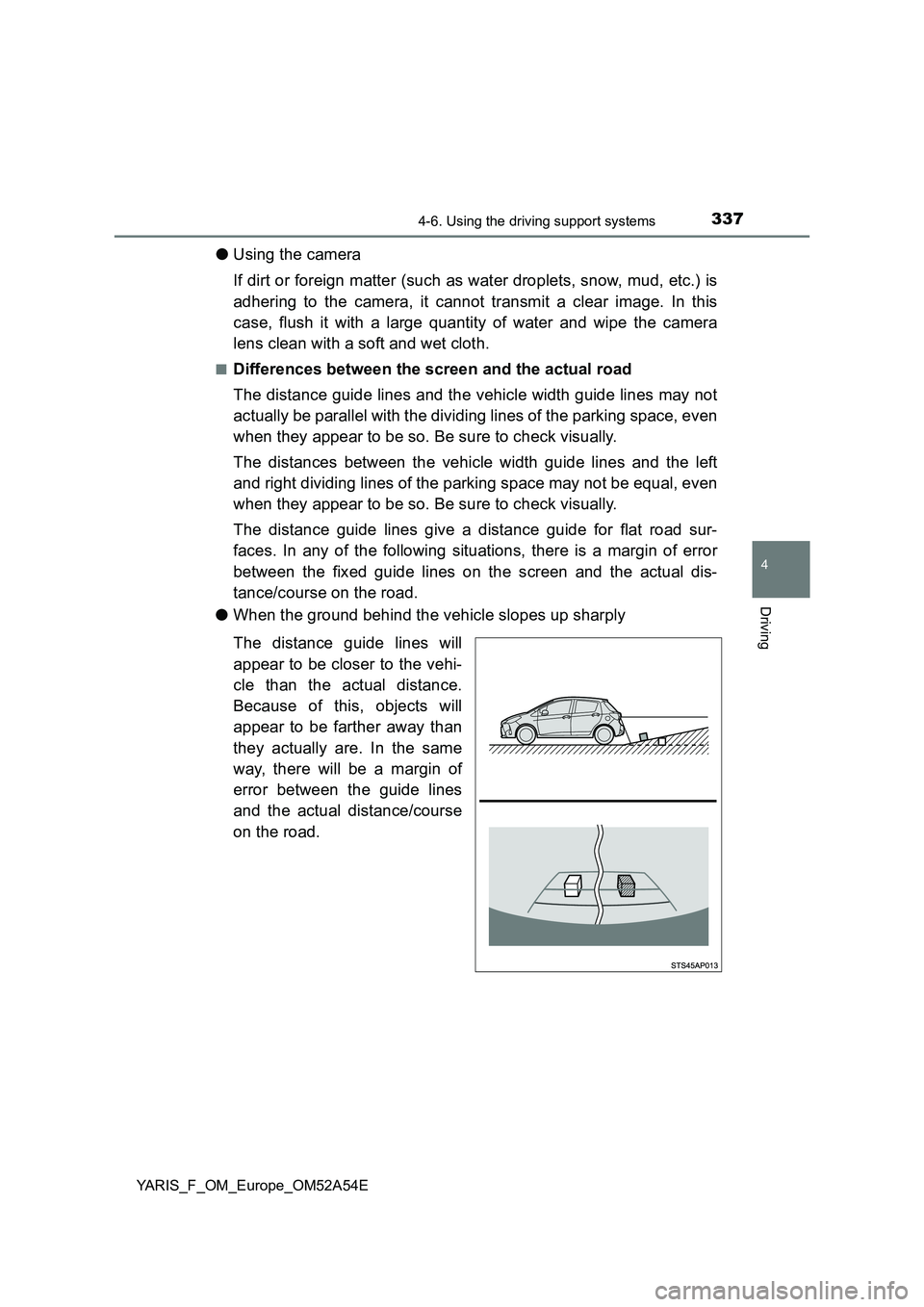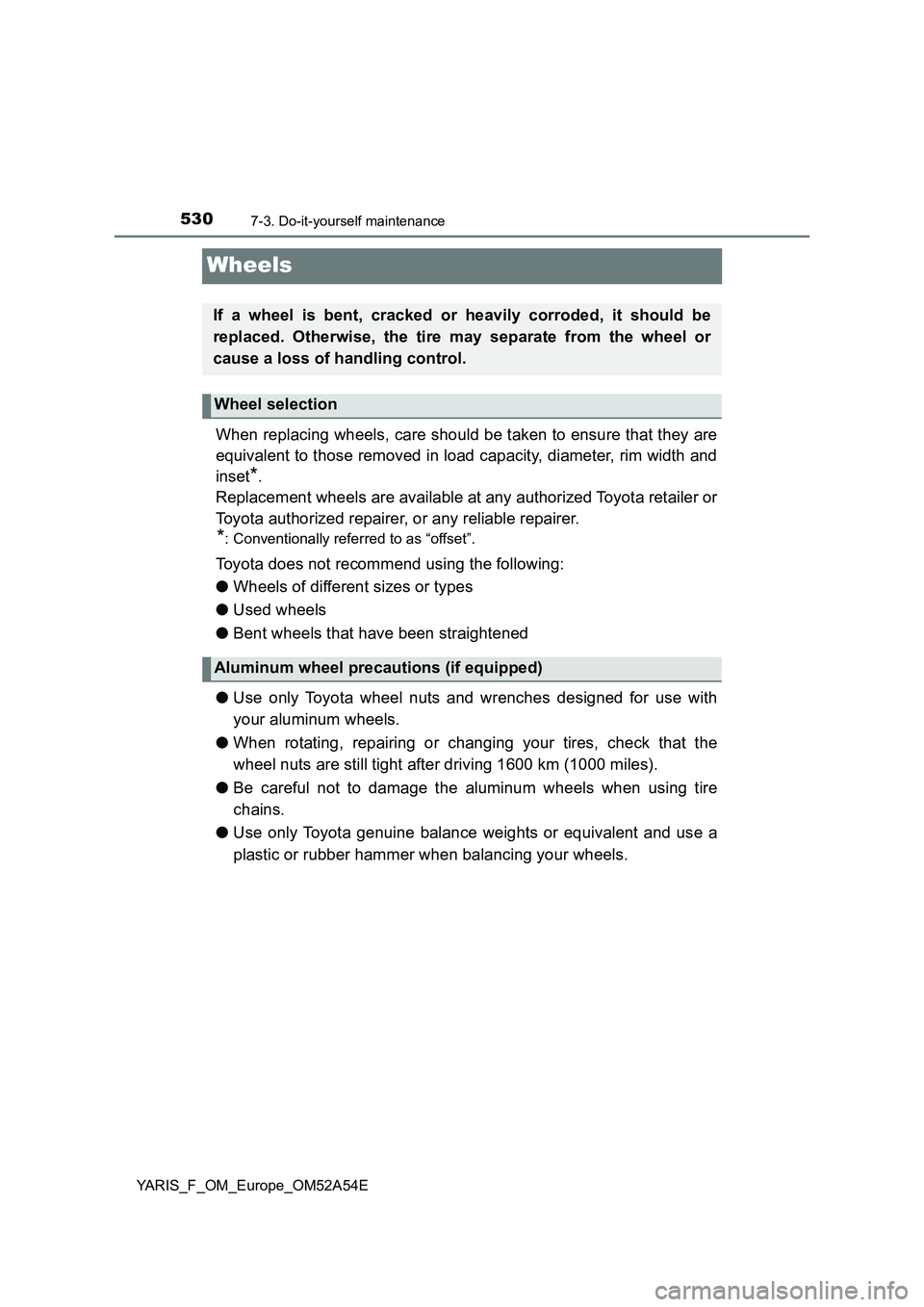Page 308 of 692
3084-5. Toyota Safety Sense
YARIS_F_OM_Europe_OM52A54E
Press the LDA switch to activate
the system.
The LDA indicator will come on.
Press the switch again to turn the
LDA system off.
The LDA system will remain on or
off even if the engine switch is
turned to “ON” position (vehicles
without a smart entry & start sys-
tem) or IGNITION ON mode (vehi-
cles with a smart entry & start
system).
●When the vehicle speed is approximately 50 km/h (32 mph) or
more
●When the lane width is more than approximately 3 m (9.8 ft.)
●When driving on a straight road or through a curve with a radius of
more than approximately 150 m (492 ft.)
Turning the LDA system on
Operating conditions
Page 335 of 692
3354-6. Using the driving support systems
4
Driving
YARIS_F_OM_Europe_OM52A54E■
Screen description
The rear view monitor system screen will be displayed if the shift
lever is shifted to R while the engine switch is in the “ON” position
(vehicles without a smart entry & start system) or IGNITION ON
mode (vehicles with a smart entry & start system).
Vehicle width guide lines
Displays a guide path when the vehicle is being backed straight up.
The displayed width is wider than the actual vehicle width.
Vehicle center guide lines
This lines indicate the estimated vehicle center on the ground.
Distance guide line
Displays a point approximately 0.5 m (1.5 ft.) (red) from the edge of the
bumper.
Distance guide line
Displays a point approximately 1 m (3 ft.) (blue) from the edge of the
bumper.
Using the rear view monitor system
1
2
3
4
Page 337 of 692

3374-6. Using the driving support systems
4
Driving
YARIS_F_OM_Europe_OM52A54E
●Using the camera
If dirt or foreign matter (such as water droplets, snow, mud, etc.) is
adhering to the camera, it cannot transmit a clear image. In this
case, flush it with a large quantity of water and wipe the camera
lens clean with a soft and wet cloth.
■Differences between the screen and the actual road
The distance guide lines and the vehicle width guide lines may not
actually be parallel with the dividing lines of the parking space, even
when they appear to be so. Be sure to check visually.
The distances between the vehicle width guide lines and the left
and right dividing lines of the parking space may not be equal, even
when they appear to be so. Be sure to check visually.
The distance guide lines give a distance guide for flat road sur-
faces. In any of the following situations, there is a margin of error
between the fixed guide lines on the screen and the actual dis-
tance/course on the road.
● When the ground behind the vehicle slopes up sharply
The distance guide lines will
appear to be closer to the vehi-
cle than the actual distance.
Because of this, objects will
appear to be farther away than
they actually are. In the same
way, there will be a margin of
error between the guide lines
and the actual distance/course
on the road.
Page 338 of 692

3384-6. Using the driving support systems
YARIS_F_OM_Europe_OM52A54E
●When the ground behind the vehicle slopes down sharply
The distance guide lines will
appear to be farther from the
vehicle than the actual dis-
tance. Because of this, objects
will appear to be closer than
they actually are. In the same
way, there will be a margin of
error between the guide lines
and the actual distance/course
on the road.
● When any part of the vehicle sags
When any part of the vehicle
sags due to the number of pas-
sengers or the distribution of
the load, there is a margin of
error between the fixed guide
lines on the screen and the
actual distance/course on the
road.
■When approaching three-dimensional objects
The distance guide lines are displayed according to flat surfaced
objects (such as the road). It is not possible to determine the posi-
tion of three-dimensional objects (such as vehicles) using the vehi-
cle width guide lines and distance guide lines. When approaching a
three-dimensional object that extends outward (such as the flatbed
of a truck), be careful of the following.
A margin of error
Page 339 of 692
3394-6. Using the driving support systems
4
Driving
YARIS_F_OM_Europe_OM52A54E
●Vehicle width guide lines
Visually check the surroundings
and the area behind the vehi-
cle. In the case shown below,
the truck appears to be outside
of the vehicle width guide lines
and the vehicle does not look
as if it hits the truck. However,
the rear body of the truck may
actually cross over the vehicle
width guide lines. In reality if
you back up as guided by the
vehicle width guide lines, the
vehicle may hit the truck.
● Distance guide lines
Visually check the surroundings
and the area behind the vehi-
cle. On the screen, it appears
that a truck is parking at point
. However, in reality if you
back up to point , you will hit
the truck. On the screen, it
appears that is closest and
is farthest away. However,
in reality, the distance to
and is the same, and is
farther than and .
2
1
1
3
1
32
13
Page 530 of 692

5307-3. Do-it-yourself maintenance
YARIS_F_OM_Europe_OM52A54E
Wheels
When replacing wheels, care should be taken to ensure that they are
equivalent to those removed in load capacity, diameter, rim width and
inset
*.
Replacement wheels are available at any authorized Toyota retailer or
Toyota authorized repairer, or any reliable repairer.
*: Conventionally referred to as “offset”.
Toyota does not recommend using the following:
●Wheels of different sizes or types
●Used wheels
●Bent wheels that have been straightened
●Use only Toyota wheel nuts and wrenches designed for use with
your aluminum wheels.
●When rotating, repairing or changing your tires, check that the
wheel nuts are still tight after driving 1600 km (1000 miles).
●Be careful not to damage the aluminum wheels when using tire
chains.
●Use only Toyota genuine balance weights or equivalent and use a
plastic or rubber hammer when balancing your wheels.
If a wheel is bent, cracked or heavily corroded, it should be
replaced. Otherwise, the tire may separate from the wheel or
cause a loss of handling control.
Wheel selection
Aluminum wheel precautions (if equipped)
Page 646 of 692
6469-1. Specifications
YARIS_F_OM_Europe_OM52A54E
Maintenance data (fuel, oil level, etc.)
Dimensions and weights
Overall length 3945 mm (155.3 in.)
Overall width 1695 mm (66.7 in.)
Overall height*11510 mm (59.4 in.)
1520 mm (59.8 in.)
*2
1530 mm (60.2 in.)*3
Wheelbase 2510 mm (98.8 in.)
Tread
Front1485 mm (58.5 in.)
*4
1475 mm (58.1 in.)*5
1470 mm (57.9 in.)*6
1465 mm (57.6 in.)*7
1460 mm (57.4 in.)*8
Rear1470 mm (57.9 in.)
*4
1460 mm (57.5 in.)*9
1455 mm (57.2 in.)*7
1445 mm (56.8 in.)*8
Gross vehicle
mass1KR-FE engine 1450 kg (3197 lb.)
2NR-FKE engine 1545 kg (3406 lb.)
Maximum
permissible
axle capacityFront
1KR-FE engine
825 kg (1819 lb.)
2NR-FKE engine
850 kg (1874 lb.)
Rear 825 kg (1819 lb.)
Drawbar load 50 kg (110 lb.)